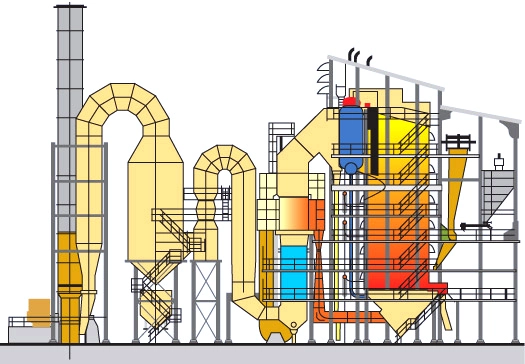
Centrifugal Pump
The most common type of slurry pump found in the oil and gas industry is surely the centrifugal pump. Centrifugal pumps include one or more impellers that transfer medium by rotation and draw medium into the suction end of the pump and then, through centrifugal power, force it out of the discharge end. This design let the pumps to be used for huge range of applications and are preferred for processes that handle low viscosity medium and high capacity. Centrifugal pumps can also deal with dirty medium or medium with low viscosity as long as they do not contain air, vapors, or a heavy amount of solids.
Centrifugal pumps are used in the upstream oil and gas industry as part of the tri-phase or multiphase pumping applications. These pumps serve a wide variety of applications with many types such as electric submersible pumps, which are used as a water and oil separator in which water can be re-injected into a reservoir without lifting it to the ground surface. They can transport a significant amount of low viscosity liquids in a short period time and can pump several hundred gallons of liquid per minute if the product is compatible.
Oil Pump
A standard oil pump mechanically lifts liquid out of an oil well when there is lack of ground pressure to force the oil onto the surface. Oil pumps are used in onshore areas where oil is abundant, but the ground needs help releasing it. These pumps can transfer one to ten gallons of fuel with every stroke depending on the depth and the weight of the oil. Deeper extractions require more massive pumps to move the oil through a vertical discharge column (discharge head). A motor that drives the vertical motion to drive the pump shaft powers the pumps. The industry term for this movement is known as a ‘walking beam.’
Diaphragm Pump
A diaphragm pump is a type of positive displacement pump that uses both a valve and a diaphragm to draw oil and gas into a refinery chamber during the upstream and midstream phase of oil refinement. When the volume of a chamber increases, the pressure in the chamber reduces, and the fluid pours into the chamber. The diaphragm then moves down and forces the liquid out. Once the fluid has cleared the chamber, the diaphragm moves back into position, allowing more fluid to enter. This cycle continues while the pump is operating.
Because of its unique design, diaphragm pumps can transport large volumes of meidum and are ideal for refineries that are located over sizable oil sources. Diaphragm pumps are also very wear-resistant than positive displacement pumps because they have fewer moving parts or friction points that wear down the components. However, diaphragm pumps do suffer from ‘winks’ – small gaps in the process that can slow down the flow of fluid. Winks and low pressure are likely to occur over long distances.
Oil Transfer Pump
An oil transfer pump is applied for moving glycol from a well to a holding tank during the midstream and downstream phases of oil refinement. Due to the high volume of activity that an oil pump engages in, they require extensive maintenance and repairs to continue working correctly. Transfer pumps create a variation in pressure that pushes fluid from one location to another. Industrial-scale slurry pumps can operate on electric, solar, hydraulic, or gas power. Oil companies use transfer pumps to move flammable or corrosive liquids like oil, gas, or chemicals. These types of pumps are secure to use for these situations because the components are manufactured with corrosion-resistant metals that hold up well in hazardous environmental conditions.
Petrochemical Pump
Petroleum products move from the upstream sector into the midstream sector of the petrochemical industry. The midstream sector transports and stores natural gas and crude oils. This is where the petrochemical pump comes in. Companies use these types of pumps to process or refine chemicals during crude oil drilling and refining. Petrochemical pumps can be piston pumps, diaphragm pumps, mag drive pumps, or another type of process pump or chemical pump.
Petrochemical pumps can operate at high capacity of flow and pressure within a refinery system. One of the good sides of petrochemical pumps is that they prevent leaks; so, they prevent hazardous environmental conditions. The similar design of the petrochemical pump, ease of use, and compactness give it the durability it needs to keep up with the demands of oil drilling. On the downside, petrochemical pumps can succumb to overheating, cavitations, and internal corrosion. Viscous, toxic, and corrosive fluids can also wear down the impellers over time.
In conclusion
Whether used during the upstream, midstream, or downstream phase, pumps give gas, oil, and other medium enough energy to flow from one place to another. Centrifugal, oil, positive displacement, oil transfer, diaphragm, and petrochemical pumps are essential in delivering oil from the ground to a tanker, then to a refinery, and then on to storage. They are also good for methanol injection, glycol pumping, chemical processing, gas sweetening, and water disposal. Pumps offer an efficient solution for transporting chemicals. Each type of pump explained above is integrated into a refining system for a specific purpose and are crucial in transporting or purifying different fluids.
